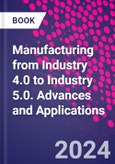Manufacturing from Industry 4.0 to Industry 5.0: Advances and Applications unfolds establishing three main pillars: (i) it investigates the theoretical background of the current industrial practice within the framework of industry 4.0 by presenting its key definitions and backbone technologies; (ii) it discusses the methods and state-of-the-art developments employed in the ongoing digital transformation of companies worldwide to promote more resilient, sustainable, and human-centric smart manufacturing and production networks; and (iii) it outlines a strategic plan for the transition from industry 4.0 to industry 5.0.
Written by an international group of expert scientists, this volume offers an overview of the most recent research in the field and provides actionable insights to benefit audiences in both academia and industry.
Please Note: This is an On Demand product, delivery may take up to 11 working days after payment has been received.
Table of Contents
Part I. From Industry 4.0 to Industry 5.0: Definition, Technological Enablers, and Comparison?
1. Introduction
2. Industry 4.0 and Smart Manufacturing
3. Industry 5.0: Perspectives, Concepts, and Technologies
4. Challenges and Opportunities of the Transition from Industry 4.0 to Industry 5.0
5. Society 5.0: Social Implications, Techno-ethics, and Social Acceptance
Part II. Industry 5.0: Human-centric, Resilient, and Sustainable Manufacturing
6. Human Cyber-Physical Systems (HCPS) for Intelligent Manufacturing
7. Resilient Manufacturing
8. Sustainable Manufacturing
Part III: Integration of Industry 4.0 Technologies in Modern Production and Manufacturing Networks Toward Industry 5.0
9. Operations Management and Information Systems for Smart Manufacturing
10. Intelligent Manufacturing
11. Industrial Internet of Things (IIoT) and Advanced Manufacturing
12. Artificial Intelligence for Human Cyber-Physical Production Systems
13. Cloud, Fog, and Edge Computing and 5G Technologies for Industrial Automation
14. From Data Collection to Advanced Analytics and Wisdom Creation in Manufacturing Processes
Part IV: Outlook and Future Directions
15. Outlook, Trends, and Future Directions Toward Industry 5.0








